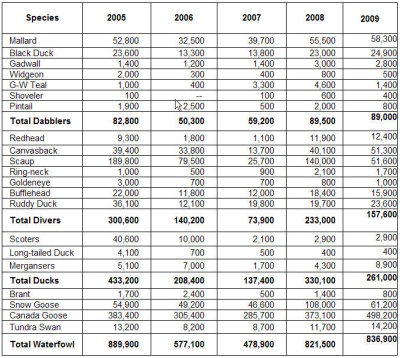
The Maryland Midwinter Waterfowl Survey numbers from 2005 to 2009. Click to enlarge. (Source: Md. DNR)
ANNAPOLIS (March 10, 2009)—The U.S. Fish and Wildlife Service and the Maryland Department of Natural Resources (DNR) have released the results of the 2009 Midwinter Waterfowl Survey. Each winter, pilots and biologists from the two agencies count ducks, geese and swans along Maryland’s Chesapeake Bay shoreline and Atlantic coast. In January of 2009, the survey teams observed a total of 836,900 waterfowl, similar to the number of waterfowl observed in January 2008.
“When pooled with results from other states, the Midwinter Waterfowl Survey provides a long-term measure of the distribution and population size of most waterfowl species wintering in the Atlantic Flyway,” said Larry Hindman, DNR Waterfowl Project Leader. “More typical winter weather led to higher numbers recorded for a few species this year.”
There was a notable increase in number of Canada geese counted by the survey crews.
The higher winter Canada goose count (498,200), was due to a combination of good gosling production from Northern Quebec nesting areas, snow cover and cold temperatures north of Maryland that pushed geese south to the Chesapeake in search of open water and winter foods.
Canada goose estimates reflect a mix of resident and migrant goose stocks, so these survey estimates are not used to set hunting regulations. Hunting regulations change with the population status of Atlantic and Resident populations of Canada geese. These numbers are tracked using breeding population and productivity surveys that are conducted each spring.
The number of mallards counted in this year’s survey (58,300) was similar to 2008 (55,500). Black duck numbers (24,900) also remained unchanged from last winter when 23,000 were counted. Overall, diving ducks numbers were similar to last winter with one exception: scaup numbers were significantly lower (51,600) compared to the 150,000 that were observed on the 2008 survey.
This year’s drop in scaup numbers in the Maryland portion of the Bay may be related to environmental factors influencing migration, but the continental population of lesser scaup has been experiencing a significant long-term decline.
The precise reasons for the decline are unknown; factors under investigation include reduced food resources, declining water quality, contaminants on spring migration stopovers and degradation of breeding habitat in the boreal forest. Climate change may also be negatively influencing food resources on boreal forest and coastal habitats.
The Midwinter Waterfowl Survey has been conducted annually throughout the United States since the early 1950s. The survey provides information on long-term trends in waterfowl populations and is the only source of population estimates for important species such as Atlantic brant and tundra swans. The survey also provides supplementary information on other waterfowl species for which annual breeding population and harvest information is available.
Source: Maryland Department of Natural Resources (DNR)


